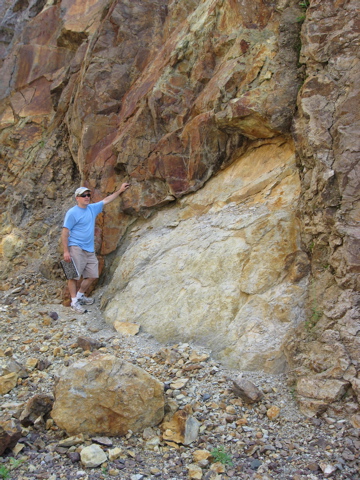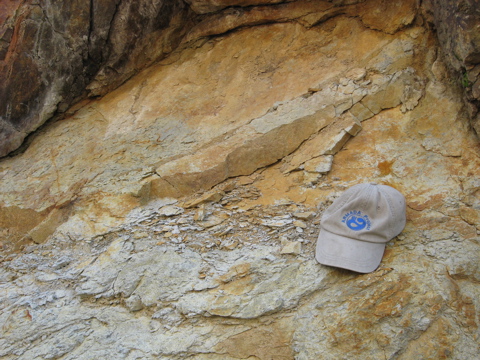Teacher Notes in Yellow
This apartment complex is the site of an old quarry (Rowe Quarry). The quarry was used to obtain red/purple rhyolite (this was commonly known as "red granite"), mainly used for crushed stone.
The highlights of this spot include contact between different igneous rocks and metamorphism related to contact between different rocks and movement between rocks. In addition you will see extensive evidence of recent weathering.
The purple rhyolite is probably part of the Lynn Volcanics, which are ancient volcanic rocks that formed in late Precambrian times. These rocks formed as the microcontinent "Avalonia" was being formed as an arc of volcanic islands. The rhyolite is an extrusive igneous rock, which formed as the volcanoes erupted. There is a small region of lighter-colored rhyolite (perhaps the "Lynn Felsite") which can be found within the red/purple rhyolite. We assume that the two types of rock formed in a similar time period, but wondering "which came first?" would be a great question for students to consider.
In addition, there are intrusions of black basalt running through the rhyolite. Basaltic intrusions typically form during periods of rifting; these probably formed as the "Boston Basin" formed. The Boston Basin is a rift basin (a region where plates are moving apart) within the Avalon microcontinent. This was around the same time as the formation of the Lynn volcanics. Again, a great question for the students to consider is which came first - the rhyolite or the basalt? While the answer may not be immediately clear, by studying the pictures below, you can determine that, at least here, the rhyolite formed first.
As you drive North on Route 1 out of Boston, after you cross over the Tobin Bridge and then the Belle Isle Marsh in Revere, you may notice a new complex of apartments on your right. The blasting of bedrock that was done to make room for these buildings reveals steep cliffs of the Lynn Volcanics. Because these cliff faces are newly exposed, whatever weathering you observe must be happening very rapidly.
Two views from the Parking Lot near main entrance
How many different kinds of rocks can you see in these two pictures? What might be the story behind this formation?
Which rock - the reddish or whitish - do you think came first? What evidence are you using to answer this question? (Also look below for close-ups of the contact between the whitish and reddish rocks.)
The question of which came first is a bit tricky. Based solely on the appearance of deformation in the red rhyolite, one might assume that the lighter "Felsite"(?) intruded into the red rhyolite. However, felsite is an extrusive rock... how could an extrusive rock intrude upon another rock? One of the two assumptions may be wrong - the type of rock, and when the deformation occured. At any rate, it's not essential to know for sure, but to raise the questions with your students.
As to the question about why one part of the red/purple rhyolie "rusts" more than other parts, there is no single best answer. Things to consider - when the rock was cut, how much water is flowing across the rock face. Is there more water seepage into the rock that has been more highly metamorphosed? Again, the point is to raise the question so that students explore possibilities, not to come up with the "right" answer.


Close-ups of light colored rhyolite (Lynn Felsite) intruding on the reddish rhyolite
In these pictures, notice the different ways the two rock types are weathering. Notice the difference in the way they crumble and fracture, as well as the color differences.


Can you see evidence of metamorphism in the purple rhyolite (look in these pictures as well as the ones directly above)? What might explain this?
The picture above right shows a very interesting metamorphic process that produces slickenside. This is a process of localized metamorphism in which minerals form on the surface between two rocks that slide past one another. The frictional heating is the source of heat for the mineral recrystallization.
Both pictures show quartz veins. This particular rhyolite has a considerable amount of embedded quartz. During metamorphism some of this quartz could have re-crystallizeds, forming these veins.





